今天,我们一起来研究一下css3中的过渡模块、2d转换模块和3d转换模块
一、过渡模块transition
(一)过度模块的三要素:
1、必须要有属性发生变化
2、必须告诉系统哪个属性需要执行过渡效果
3、必须告诉系统过渡效果持续时长
ps:当多个属性需要同时执行过渡效果时用逗号隔开即可
transition-property: width, background-color;
transition-duration: 5s, 5s;
示例代码:
<!DOCTYPE html> <html lang="en"> <head> <meta charset="UTF-8"> <title>过渡模块</title> <style> *{ margin: 0; padding: 0; } div{ width: 100px; height: 50px; background-color: red; /*告诉系统哪个属性需要执行过渡效果*/ transition-property: width, background-color; /*告诉系统过渡效果持续的时长*/ transition-duration: 5s, 5s; } /*
用来改变元素的属性
:hover这个伪类选择器除了可以用在a标签上, 还可以用在其它的任何标签上
*/ div:hover{ width: 300px; background-color: blue; } </style> </head> <body> <div></div> </body> </html>
效果图:
 变化前
变化前
 变化中
变化中
 变化后
变化后
(二)过渡模块的其它属性:
1、告诉系统延迟多少秒之后才开始过渡动画:transition-delay: 2s;
2、告诉系统过渡动画的运动的速度:transition-timing-function: linear;
示例代码:
<!DOCTYPE html> <html lang="en"> <head> <meta charset="UTF-8"> <title>89-过渡模块-其它属性</title> <style> *{ margin: 0; padding: 0; } div { width: 100px; height: 50px; background-color: red; transition-property: width; transition-duration: 5s; /*告诉系统延迟多少秒之后才开始过渡动画*/ transition-delay: 2s; } div:hover{ width: 300px; } ul{ width: 800px; height: 500px; margin: 0 auto; background-color: pink; border: 1px solid #000; } ul li{ list-style: none; width: 100px; height: 50px; margin-top: 50px; background-color: blue; transition-property: margin-left; transition-duration: 10s; } ul:hover li{ margin-left: 700px; } ul li:nth-child(1){ /*告诉系统过渡动画的运动的速度*/ transition-timing-function: linear; } ul li:nth-child(2){ transition-timing-function: ease; } ul li:nth-child(3){ transition-timing-function: ease-in; } ul li:nth-child(4){ transition-timing-function: ease-out; } ul li:nth-child(5){ transition-timing-function: ease-in-out; } </style> </head> <body> <!--<div></div>--> <ul> <li>linear</li> <li>ease</li> <li>ease-in</li> <li>ease-out</li> <li>ease-in-out</li> </ul> </body> </html>
不同的运动速度会导致不同的过渡效果,请看运行效果图:
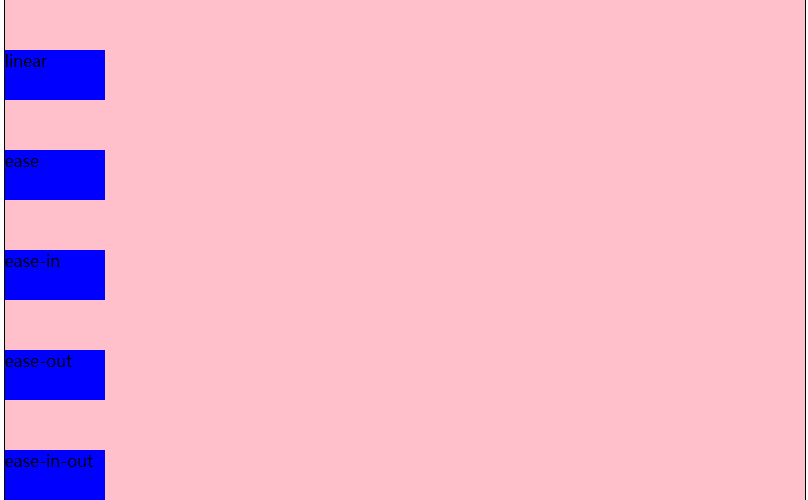 运动前
运动前
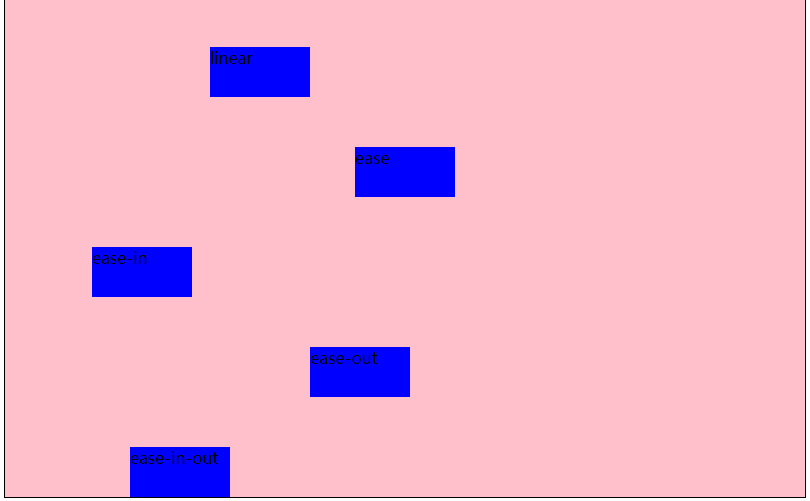 运动中
运动中
 运动后
运动后
(三)过渡连写格式
transition: 过渡属性 过渡时长 运动速度 延迟时间;
过渡连写注意点
1和分开写一样, 如果想给多个属性添加过渡效果也是用逗号隔开即可
2连写的时可以省略后面的两个参数, 因为只要编写了前面的两个参数就已经满足了过渡的三要素
3如果多个属性运动的速度/延迟的时间/持续时间都一样, 那么可以简写为:transition:all 0s;
示例代码:
<!DOCTYPE html> <html lang="en"> <head> <meta charset="UTF-8"> <title>过渡模块的连写</title> <style> *{ margin: 0; padding: 0; } div { width: 100px; height: 50px; background-color: red; /*注释中为简写前的代码: transition-property: width; ransition-duration: 5s; transition: width 5s linear 0s,background-color 5s linear 0s; transition: background-color 5s linear 0s; transition: width 5s,background-color 5s,height 5s;*/ /*下面为简写后的代码*/ transition: all 5s; } div:hover{ width: 300px; height: 300px; background-color: blue; } </style> </head> <body> <div></div> </body> </html>
(四)过度模块的编写套路和案例
编写套路:
1、不要管过渡, 先编写基本界面
2、修改我们认为需要修改的属性
3、再回过头去给被修改属性的那个元素添加过渡即可
案例1:
思路:
1、先做好基本页面布局,给div和span添加样式表;
2、考虑怎么实现要做的效果,和需要变动的属性
3、给属性添加过渡效果,在只有一种属性变动或多个属性过渡时间等相同的情况下推荐使用:transition:all 1s;
<!DOCTYPE html> <html lang="en"> <head> <meta charset="UTF-8"> <title>过渡模块-弹性效果</title> <style> *{ margin: 0; padding: 0; } div{ height: 150px; background-color: green; margin-top: 100px; text-align: center; line-height: 150px; } div span{ font-size: 80px; transition: margin 3s; } div:hover span{ margin: 0 20px; } </style> </head> <body> <div> <span>L</span> <span>M</span> <span>S</span> <span>码</span> <span>农</span> <span>来</span> <span>过</span> <span>渡</span> </div> </body> </html>
示例图片:
 过渡前
过渡前
 过渡中
过渡中
 过度后
过度后
案例2:
手风琴效果,示例代码:
<!DOCTYPE html> <html lang="en"> <head> <meta charset="UTF-8"> <title>过渡模块-手风琴效果</title> <style> *{ margin: 0; padding: 0; } ul{ width: 960px; height: 300px; margin: 100px auto; border: 1px solid #000; overflow: hidden; } ul li{ list-style: none; width: 160px; height: 300px; float: left; transition: width 0.5s; } ul:hover li{ width: 100px; } ul li:hover{ width: 460px; } </style> </head> <body> <ul>
/*这里为了方便使用了行内样式表,实际应用中一般为图片,要注意样式与内容分离*/
<li style="background-color: #ccc;"></li> <li style="background-color: #e5ce8a;"></li> <li style="background-color: #eac123;"></li> <li style="background-color: #a00;"></li> <li style="background-color: #cc0;"></li> <li style="background-color: #0cc;"></li> </ul> </body> </html>
思路:
1、通过浮动做好基本布局,如图:
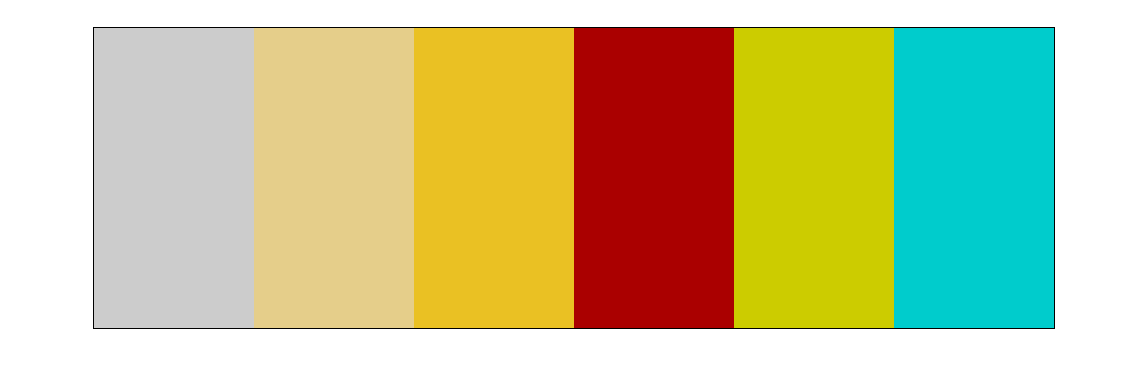
2、考虑需要实现的效果,如下图,即鼠标移入后,具有:hover事件的li宽度变大,其余的等大。
我们可以通过ul的:hover事件让所有的li变小,然后通过li的:hover时间来使当前li宽度变大。案例事小,思路是大,这种思路在以后的js中或者其他的地方经常用到,即先将所有元素初始化,在单独改变需要改变的元素属性。

二、2d转换模块transform
(一)写法:transform:值;transform的值常用的有3种:
1、旋转:其中deg是单位, 代表多少度:transform: rotate(45deg);
2、移动:第一个参数:水平方向,第二个参数:垂直方向,transform: translate(100px, 0px);
3、缩放:第一个参数:水平方向,第二个参数:垂直方向,transform: scale(0.5, 0.5);transform: scale(1.5);
注意点:
如果取值是1, 代表不变
如果取值大于1, 代表需要放大
如果取值小于1, 代表需要缩小
如果水平和垂直缩放都一样, 那么可以简写为一个参数
ps:1、如果需要进行多个转换, 那么用空格隔开
2、2D的转换模块会修改元素的坐标系, 所以旋转之后再平移就不是水平平移的
示例代码:
<!DOCTYPE html> <html lang="en"> <head> <meta charset="UTF-8"> <title>2D转换模块</title> <style> *{ margin: 0; padding: 0; } ul{ width: 800px; height: 500px; border: 1px solid #000; margin: 0 auto; } ul li{ list-style: none; width: 100px; height: 50px; background-color: red; margin: 0 auto; margin-top: 50px; text-align: center; line-height: 50px; } ul li:nth-child(2){ transform: rotate(45deg); } ul li:nth-child(3){ transform: translate(100px, 0px); } ul li:nth-child(4){ transform: scale(1.5); } ul li:nth-child(5){ transform: rotate(45deg) translate(100px, 0px) scale(1.5, 1.5); /*transform: translate(100px, 0px);*/ } </style> </head> <body> <ul> <li>正常的</li> <li>旋转的</li> <li>平移的</li> <li>缩放的</li> <li>综合的</li> </ul> </body> </html>
示例图片:
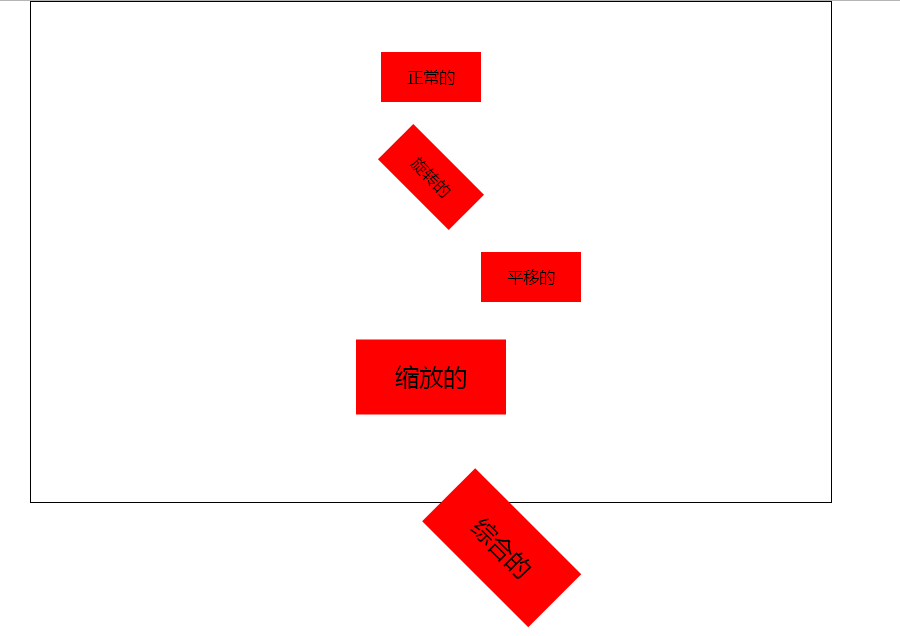
(二)转换模块的形变中心点:
默认情况下所有的元素都是以自己的中心点作为参考来旋转的, 我们可以通过形变中心点属性来修改它的参考点。
1、写法:transform-origin: left top;第一个参数:水平方向,第二个参数:垂直方向。
ps:取值有三种形式
具体像素:transform-origin: 200px 0px;
百分比:transform-origin: 50% 50%;
特殊关键字:transform-origin: center center;
2、示例代码:
<!DOCTYPE html> <html lang="en"> <head> <meta charset="UTF-8"> <title>2D转换模块的形变中心点</title> <style> *{ margin: 0; padding: 0; } ul{ width: 200px; height: 200px; border: 1px solid #000; margin: 100px auto; position: relative; } ul li{ list-style: none; width: 200px; height: 200px; position: absolute; left: 0; top: 0; transform-origin: left top; } ul li:nth-child(1){ background-color: red; transform: rotate(30deg); } ul li:nth-child(2){ background-color: green; transform: rotate(50deg); } ul li:nth-child(3){ background-color: blue; transform: rotate(70deg); } </style> </head> <body> <ul> <li></li> <li></li> <li></li> </ul> </body> </html>
(三)2d转换模块的旋转轴
rotate旋转属性旋转是默认都是围绕z轴旋转,若需要改变旋转轴可以在rotate后加上旋转轴,即:rotateX();rotateY();rotateZ();
1、当围绕x和y轴旋转时就会改变属性距离我们的距离,也就是透视,什么事透视呢,就是近大远小。
2、你会发现元素围绕x轴或y轴旋转时并没有金达远小的效果,这时你需要添加一个透视属性:perspective: 500px;注意:这个属性需要添加在元素的父容器上;
<!DOCTYPE html> <html lang="en"> <head> <meta charset="UTF-8"> <title>旋转轴向</title> <style> *{ margin: 0; padding: 0; } ul{ width: 800px; height: 500px; margin: 0 auto; } ul li{ list-style: none; width: 200px; height: 200px; margin: 0 auto; margin-top: 50px; border: 1px solid #000; transform:perspective(500px);
} ul li div{ width: 200px; height: 200px; background-color: #ac4345; } ul li:nth-child(1) div{ transform: rotateZ(45deg); } ul li:nth-child(2) div{ transform: rotateX(45deg); } ul li:nth-child(3) div{ transform: rotateY(45deg); } </style> </head> <body> <ul> <li><div></div></li> <li><div></div></li> <li><div></div></li> </ul> </body> </html>
示例图片:
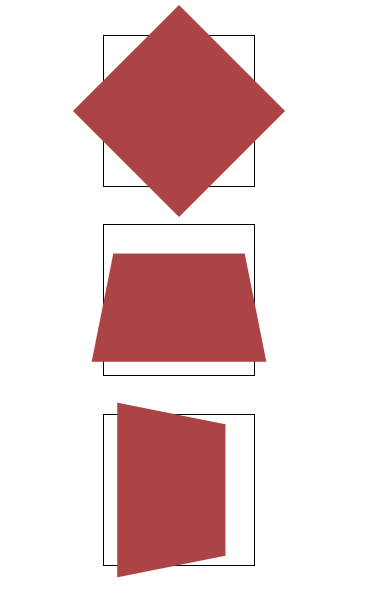
今天的分享到这里就结束了,希望大家能有一些收获。大家有什么意见和建议也可以在留言区留言,谢谢大家的支持。
